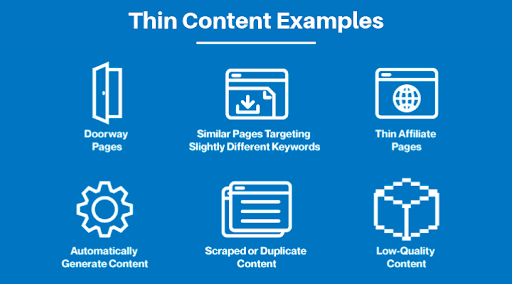Simply put, if you are creating content that offers little or no value to the readers, lacks depth, or is repetitive or scraped, it can be termed thin content. And it is really bad for your website SEO.
Why?
Try to think why people use Google or other search engines. They need information and insights into their queries, right?
And that is what Google wants – that their audience is presented with the best content so that they keep coming back. Think about why they added an extra “E” to their E-A-T guidelines. (E.E.A.T – Experience, Expertise, Authoritativeness, and Trustworthiness).
Let’s try to get a better insight into thin content, its impact on SEO, and how you can fix it.
Understand Clearly What Falls in the Definition of Thin Content

By now, you must recognize that thin content is what we call, in layman’s language, “useless content.” Content that lacks real value, is not original, is stuffed with keywords, and has no useful information is thin content.
Here are some key points that will help you characterize thin content on your website:
- Lacks Depth: Content that doesn’t provide in-depth information or answer user queries comprehensively.
- Duplicate Content: Replicating the same content across multiple landing pages or copying content from other sites without adding value.
- Keyword Stuffing: Overloading content with keywords in an unnatural manner, making it unreadable and unhelpful to users.
- Auto-generated Content: Content produced using automated tools without human oversight, leading to incoherence or irrelevance.
- Doorway Pages: Pages that are created to rank for specific search queries but just redirect users to another page without offering valuable content.
- Low Word Count: Very short articles or posts that don’t delve into the topic deeply enough to be valuable.
- Irrelevant Content: Information that doesn’t match the title or metadata, misleading users.
- Lack of Originality: Content that offers nothing new, just rehashes what’s already available elsewhere without offering a fresh perspective or additional insights.
How Does Thin Content Affect SEO
Search engines, including Google, are opposed to Thin Content. Anything that spoils customer experience is penalized by them. Thin content can significantly impact the website’s SEO and performance results. Here’s what happens when you use thin content:
- Search Engine Penalties: Algorithms like Google’s Panda can push your website down the rankings. Reduced visibility equals decreased organic traffic.
- Increased Bounce Rate: Visitors leave your site quickly if the content doesn’t meet their expectations, signaling search engines that your site may lack value.
- Decreased Indexation: Search engines may crawl and index your site less frequently if they detect the presence of thin content.
- You lose Trust and Authority: High-quality content builds credibility. Thin content can erode this trust, making it challenging to earn backlinks and referrals.
- Difficulty in Keyword Ranking: Without substantial content, your chances of ranking for both primary and long-tail keywords diminish.
- Lack of Shareability: Thin content rarely gets shared on social media platforms, leading to fewer social signals, which can indirectly influence SEO.
- Reduced Conversion Rate: Your ideal customers are less likely to take desired actions on pages with little valuable content.
- Negative User Feedback: Continual reports of low-quality content can be a red flag for search engines when determining your site’s ranking.
Using thin content can jeopardize your website’s SEO performance and user trust. Therefore, you must prioritize depth, relevance, and value in your content strategy.
How Do You Fix Thin Content?

It’s understandable how you would feel when you discover that thin content might be holding your website back. It’s not just about search engines but also about offering value to your cherished visitors.
Here’s a guide crafted just for you to help you transform any thin content and put your best foot forward:
Take a Deep Breath and Audit:
First, don’t panic! Start with content marketing tools to pinpoint potential thin content. Review those pages. Remember, every site has a few. The goal is to reduce them.
Combine Forces:
Got several short posts on nearly the same topic? Think about weaving them together into one stellar, comprehensive piece.
Dive Deeper:
Every topic has hidden depths. Add relevant details, stories, or even personal experiences. Your readers will thank you for it.
Polish Until It Shines:
Quality counts. Make sure your content is not just longer but better. Fact-check, spell-check, and read it aloud.
Lift the Experience:
You can use image or short video in your content. Think about what visuals could elevate your content and make it more engaging.
Sprinkle Keywords Naturally:
Remember those phrases your audience uses to find content like yours? Use them naturally. It’s like seasoning – just the right amount makes the dish perfect.
Consider Letting Some Pages Go:
If a page doesn’t serve a purpose anymore and isn’t salvageable, it might be time to say goodbye. If you’re hesitant, use the ‘noindex’ tag. It’s okay to let go.
Keep It Fresh:
The web changes, and so should your content. Periodic updates keep your content relevant and show both users and search engines that you care. Use email marketing campaigns to keep your audience apprised of fresh content.
Listen to Your Visitors:
They’re your best critics. A little feedback through Salesforce forms can point out areas you might’ve overlooked.
Keep Tabs on Your Progress:
Check in on your website’s analytics. Celebrate the pages that see improvement in engagement, and re-evaluate the ones that don’t. Email lists and website analytics are two effective marketing strategies that work well together to boost your SEO rankings.
You can monitor how users are interacting with your website, the pages they are visiting, and how long they are spending on it with the help of website analytics. You can utilize this data to enhance the look and feel of your website and pinpoint areas in which your SEO efforts need to be strengthened. With email lists, you can remain in contact with visitors to your website and send them messages that are specifically tailored to their interests. Make sure to use an email verification tool to verify the emails are genuine before going forward with your campaigns.
Share and Encourage Sharing:
Quality content deserves to be seen. Share it on your Instagram handle and social media pages and encourage others to do the same. Those backlinks can be gold!
Stay Unique:
Your voice is yours alone. Ensure that each page reflects that uniqueness, free from duplicate content.
If you find this too overwhelming, you can hire an expert using recruitment software to find and heal your thin content.
Also Read: How To Hire The Perfect Person for Your Social Media
Final Thoughts
It might feel overwhelming when you first hear terms like “thin content” and think about how it’s affecting your website. It’s a crucial realization and, honestly, a significant first step.
By now, you know why search engines like Google care about it and why it’s so vital for your audience’s experience.
Think of it this way: your website is your digital home, and just like our real homes, we want our guests to feel welcomed, informed, and taken care of. That’s what rich, valuable content does.
If you’ve identified thin content areas on your site, don’t be disheartened. It’s an opportunity, a chance for you to delve deeper and offer something even more incredible.

